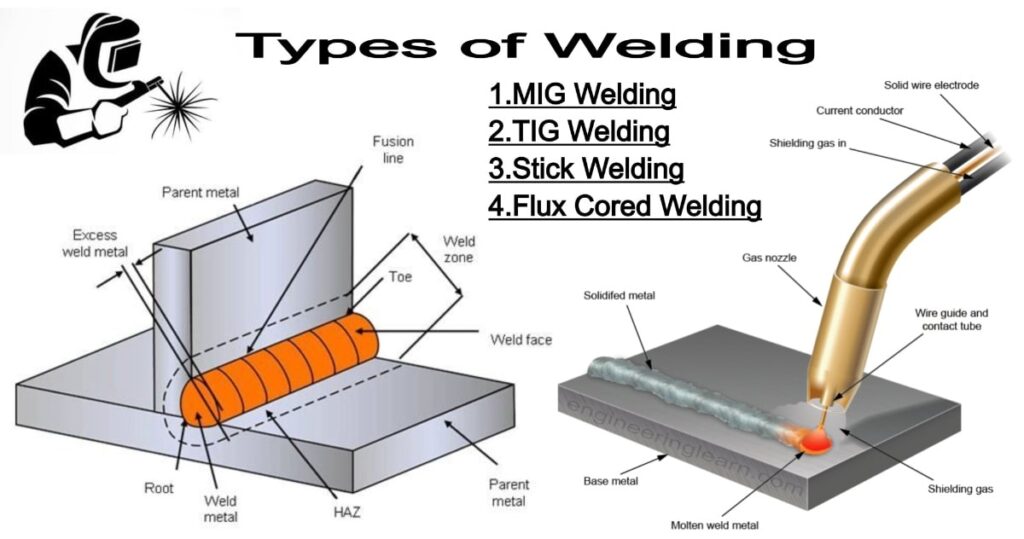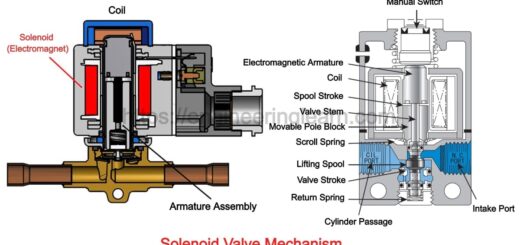Types of Welding: MIG Welding, TIG Welding, Stick Welding & Flux Cored Welding

What is Welding?
Types of Welding: MIG Welding, TIG Welding, Stick Welding & Flux Cored Welding :– Welding refers to as a process that is done to join two or more metals or thermoplastics, by the use of excessively high heat, to melt the parts together and then allow them to cool, causing fusion. The process is different from low temperature metal-joining techniques like brazing or soldering, which do not let the base metal melt.
Other than this, the material used is typically a filling material which is added to the joints to form a weld pool of the molten material that cools to form a strong joint based on the configuration of the weld. The material weld can be stronger than the parent material.
The heat pressure may be used to produce a stronger weld as per the specific site requirement and also requires a shield to protect the melted metals from being contaminated or oxidized.
There are various energy sources which can be used for executing the process of welding, the examples of which are a gas flame, an electrical arc, a laser, an electron beam, friction, ultrasound etc. In industries welding can be performed in various environments which can include an open air, under water, outer space etc.
Welding is a quite hazardous process for which appropriate precautions should be taken to avoid burning, electric shock, vision damage, inhaling poisonous gases and exposure to intense ultraviolet radiation.
The tool used to execute the welding process is a welding machine or gun or welder which is the most essential tool used. This tool is used to generate high heat which is used to melt the metal, so that these can be joined together. However, there are various welding machines which are used depending upon the site condition.
Types of Welding and Its Benefits
It is important to know which kind of welding technique you need to apply according to the site requirement as each and every technique requires a particular type of welder.
1. MIG Welding: ( Types of Welding )
The technique is used wherein a wired welding electrode on a spool is fed at a constant speed. The arc is created by involving an electric current between the base metal and the wire. Benefits of MIG welding are as follows:
- Quite easy to learn
- Very high welding speed
- Its application is appreciable with thin and thick metals
- The technique offers cleaner welds with no slag
- The same equipment can be used again for flux-cored welding
2. TIG Welding: ( Types of Welding )
This technique of welding is done with the help of a non-consumable tungsten electrode. The consistent feed of energy crosses the arc. Thus, the shielding gas protects the welded area. The benefits of using this technique should be known to each of us:
- The technique works well in thin sections of alloy steels, stainless steels, and non-ferrous metals like aluminium, magnesium, copper etc.
- High quality with accurate and precise welds.
- Forms weld beads which give an attractive look.
- The technique allows the heat input adjustment while welding using a foot control.
3. Stick Welding: ( Types of Welding )
Stick welding is done with the involvement of an electric current flow from a gap between metal and the welding stick or welding electrode. Stick welder works amazingly on stainless steel and cast iron. Benefits of stick welding are as follows:
- Works with almost all alloys.
- The technique is well suited for indoor as well as outdoor areas.
- Its application is appreciable on rusty and dirty metals.
- This technique is good for thicker metals and is comparatively cost effective.
4. Flux-Cored Welding: ( Types of Welding )
This technique uses a wired electrode which is fed constantly. Though it does not need any shielding gas still the flux-cored wire shields the arc instead. The benefits of using this technique should be known to each of us:
- The technique is perfect to works well in windy conditions
- Its application is appreciable on rusty and dirty metals.
- The technique is suitable for out-position welding
- High rate of metal deposition
Welding Considerations
It is important to know the correct welding technique which should be considered in order to execute the welding process accurately.
1. Type of Machine
It is important to know the type of machine to make welding an easy task. In case you are an advanced welding professional then you would require a machine with more power for which you may want a TIG welder.
2. Types of Metal
It is important to know the welder which works well with all types of metals or alloys. TIG welder is one amongst them which works with all, except the cast iron whereas MIG welding is ideal for stainless steel and aluminum.
3. Quality of the Weld
If you wish to opt for a high quality weld which does not look shabby then you must select a TIG welder. If you wish to create a strong weld between the rusty or dirty metals then you can select a stick or flux-cored welding machine.
4. Welding Conditions
The site condition should be well known before selecting the type of welding. For example a windy area would require a stick or flux-cored welder. Referring to the site condition will help to execute the welding procedure well.
5. Power Source
For welding any material it is important to know the power source which will be used to weld that particular material. For instance, steel and stainless steel are welded with a DC output only whereas aluminum and magnesium are welded with an AC output. Therefore it is important to know the type of material to choose the correct combination of either AC or DC power source.
6. Welding Duty Cycle
Duty cycle refers to the amount of time for which you can weld without overheating or burning the power source or the machine. For instance, a hobby welder may only need 20% duty cycle, a professional might use 100% duty cycle. Mostly duty cycles ranging 40%-60% are sufficient.
7. Thickness of the Metal
From the above details it can be known the stick welding machines are well suited for thick metals and MIG or TIG welders are well suited for thin metals. For instance, the car manufacturing industry involves welding of numerous thin metals.
8. Portable Welding
If there is no power source on the working site then you would be in a need of a portable welder which would work with either an inverter or a one which shall be an engine-driven welder.
Image Source :- cwbgroup, twi-global, stock.adobe













